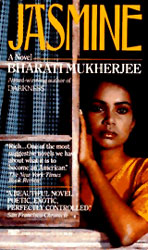A much acclaimed work, Jasmine is a depiction of the hypersensitive mind of a female. The central character, Jasmine gains a remarkable dimension in this novel whilst making the novel to stand out with pride.
The author Bharati Mukherjee lives her life with distinctly different experiences she has had throughout life. Because of this reason she has been described as a writer who has lived through several phases of life. At first she lives as a colonial, then national subject in India. After that she led a life of exile as a post-colonial Indian in Canada. Finally, she shifted into a celebratory mode as an immigrant and finally a citizen in the United States. She considers her work a celebration of her emotions that she brings out of her heart. Her main theme throughout her writing discusses the condition of Asian immigrants in North America, with particular attention to the changes taking place in South Asian women in a new world. She shows all her characters as survivors against the brutalities and violence surrounding them who are often victimized by various forms of social oppression. Her works are praiseworthy because of its prose style, ironic plot developments and witty observations. She always sees the world in a minute way and so do her characters. She is often racially categorized by her thematic focus and cultural origin. Bharati Mukherjee prefers to refer to herself as an American of Bengali-Indian origin.
Synopsis:
 The main backdrop of Jasmine is set at the idea of mixing of the East and West with a story telling of a young Hindu woman who leaves India for the U.S. after her husband`s murder. In her path she faces many problems including rape and eventually returned to the position of a health professional through a series of jobs. Here in this context the unity between the First and Third world is shown to be in the treatment of women as subordinate in both countries. The story expanded as a story of a young widow suddenly widowed at seventeen. She uproots herself from her life in India and re-roots herself in search of a new life and the image of America as well. It is a story of dislocation and relocation as the protagonist continually sheds lives to move into other roles, moving further westward. The author in some parts of this novel shows some agony to the third world as she shows that Jasmine needs to travel to America to make something significant in her life. And in the third world she faced only despair and loss. In Jasmine, Bharati Mukherjee has created a heroine as exotic and unexpected as the many worlds in which she lives.
The main backdrop of Jasmine is set at the idea of mixing of the East and West with a story telling of a young Hindu woman who leaves India for the U.S. after her husband`s murder. In her path she faces many problems including rape and eventually returned to the position of a health professional through a series of jobs. Here in this context the unity between the First and Third world is shown to be in the treatment of women as subordinate in both countries. The story expanded as a story of a young widow suddenly widowed at seventeen. She uproots herself from her life in India and re-roots herself in search of a new life and the image of America as well. It is a story of dislocation and relocation as the protagonist continually sheds lives to move into other roles, moving further westward. The author in some parts of this novel shows some agony to the third world as she shows that Jasmine needs to travel to America to make something significant in her life. And in the third world she faced only despair and loss. In Jasmine, Bharati Mukherjee has created a heroine as exotic and unexpected as the many worlds in which she lives.
Being published by Grove Pr, Viking Books and Virago Press Ltd. `Jasmine` is a story about a girl who is widowed at the age of seventeen years and eventually shifted to America.
`Jasmine` is an acclaimed work of Bharati Mukherjee. It is a novel that stems from an earlier short story from `The Middleman and Other Stories.` This is a life story of a girl where the title character is the protagonist. The story is all about an Indian refugee who is empowered by the trials of assimilation.













